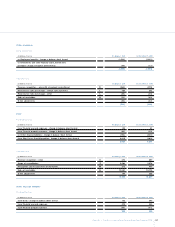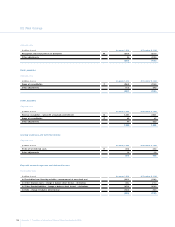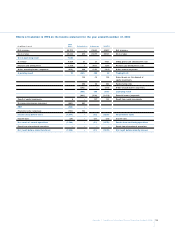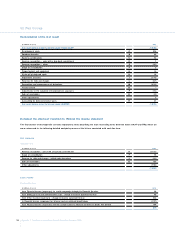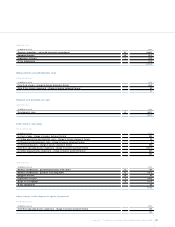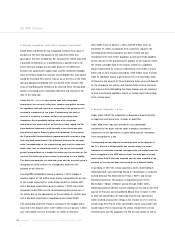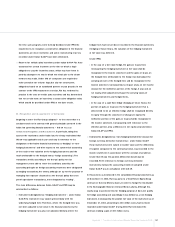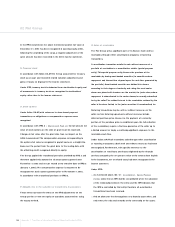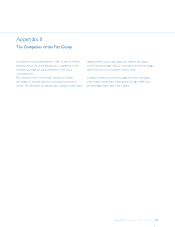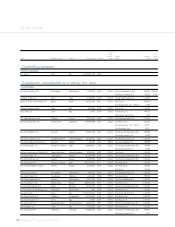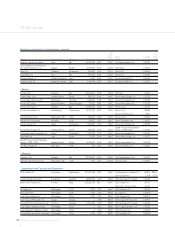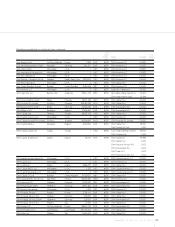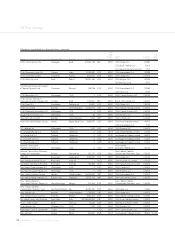Chrysler 2005 Annual Report Download - page 168
Download and view the complete annual report
Please find page 168 of the 2005 Chrysler annual report below. You can navigate through the pages in the report by either clicking on the pages listed below, or by using the keyword search tool below to find specific information within the annual report.
167
Appendix 1 Transition to International Financial Reporting Standards (IFRS)
the time such programs were formally decided. Under IFRS the
requirements to recognise a constructive obligation in the financial
statements are more restrictive, and some restructuring reserves
recorded under Italian GAAP have been eliminated.
Reserve for vehicle sales incentives: under Italian GAAP Fiat Auto
accounted for certain incentives at the time at which a legal
obligation to pay the incentives arose, which may have been in
periods subsequent to that in which the initial sale to the dealer
network was made. Under IAS 37 companies are required to
make provision not only for legal, but also for constructive,
obligations based on an established pattern of past practice. In the
context of the IFRS restatement exercise, Fiat has reviewed its
practice in the area of vehicle sales incentives and has determined
that for certain forms of incentives a constructive obligation exists
which should be provided under IFRS at the date of sale.
M . Recognition and measurement of derivatives
Beginning in 2001 the Fiat Group adopted – to the extent that it is
consistent and not in contrast with general principles set forth in the
Italian law governing financial statements – IAS 39 Financial
Instruments:Recognition and M easurement. In particular, taking into
account the restrictions under Italian law, the Group maintained that
IAS 39 was applicable only in part and only in reference to the
designation of derivative financial instruments as “hedging” or “non-
hedging instruments” and with respect to the symmetrical accounting
of the result of the valuation of the hedging instruments and the
result attributable to the hedged items (“hedge accounting”).The
transactions which, according to the Group’s policy for risk
management, were able to meet the conditions stated by the
accounting principle for hedge accounting treatment, were designated
as hedging transactions; the others, although set up for the purpose of
managing risk exposure (inasmuch as the Group’s policy does not
permit speculative transactions), were designated as“trading”.
The main differences between Italian GAAP and IFRS may be
summarized as follows:
Instruments designated as “hedging instruments” - under Italian
GAAP, the instrument was valued symmetrically with the
underlying hedged item.Therefore, where the hedged item was
not been adjusted to fair value in the financial statements, the
hedging instrument was also not adjusted. Similarly, where the
hedged item had not yet been recorded in the financial statements
(hedging of future flows), the valuation of the hedging instrument
at fair value was deferred.
Under IFRS:
- In the case of a fair value hedge, the gains or losses from
remeasuring the hedging instrument at fair value shall be
recognised in the income statement and the gains or losses on
the hedged item attributable to the hedge risk shall adjust the
carrying amount of the hedged item and be recognised in the
income statement. Consequently, no impact arises on net income
(except for the ineffective portion of the hedge, if any) and on
net equity, while adjustments impact the carrying values of
hedging instruments and hedged items.
- In the case of a cash flow hedge (hedging of future flows), the
portion of gains or losses on the hedging instrument that is
determined to be an effective hedge shall be recognised directly
in equity through the statement of changes in equity; the
ineffective portion of the gains or losses shall be recognised in
the income statement. Consequently, with reference to the
effective portion, only a difference in net equity arises between
Italian GAAP and IFRS.
Instruments designated as “non-hedging instruments”(except for
foreign currency derivative instruments) - under Italian GAAP,
these instruments were valued at market value and the differential,
if negative compared to the contractual value, was recorded in the
income statement, in accordance with the concept of prudence.
Under IAS 39 also the positive differential should also be
recorded.W ith reference to foreign currency derivative
instruments, instead, the accounting treatment adopted under
Italian GAAP was in compliance with IAS 39.
In this context, as mentioned in the consolidated financial statements as
of D ecember 31, 2003, Fiat was party to a Total Return Equity Swap
contract on General Motors shares, in order to hedge the risk implicit
in the Exchangeable Bond on General Motors shares.Although this
equity swap was entered into for hedging purposes it does not qualify
for hedge accounting and accordingly it was defined as a non-hedging
instrument. Consequently, the positive fair value of the instrument as of
December 31, 2003, amounting to 450 million euros, had not been
recorded under Italian GAAP. During 2004 Fiat terminated the
contract, realising a gain of 300 million euros.


